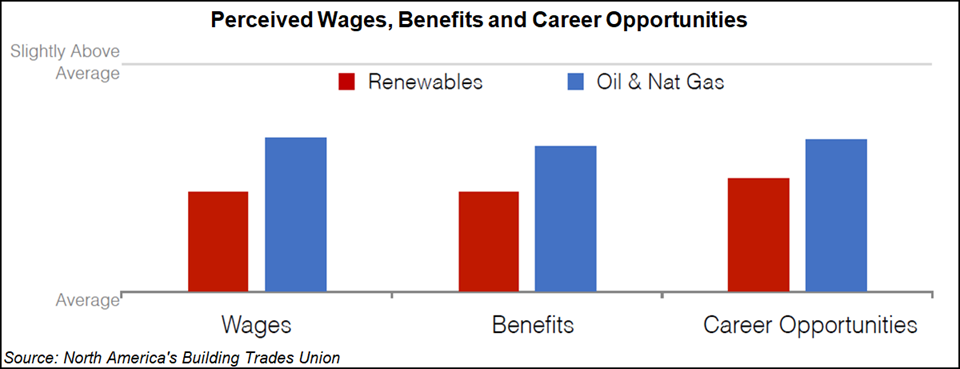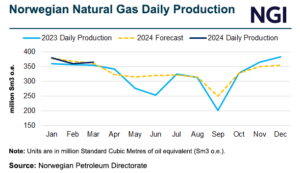Construction Work in Oil, Natural Gas Surpass Renewable Jobs, Says Building Trades Union
Construction workers in the energy sector view oil and natural gas jobs as more plentiful and longer lasting, as well as providing better pay, health and pension benefits, than similar jobs in the renewables segment, according to two surveys commissioned by North America’s Building Trades Unions (NABTU).

Through the surveys, one quantitative and one qualitative, NABTU, which represents three million tradespeople across 14 craft unions, sought to better understand the role of trades jobs in the U.S. economy, and the differences in those jobs across various segments of the energy sector.
“Energy construction workers affirm that projects in oil and natural gas have better wages, benefits and opportunities than renewable projects,” President Sean McGarvey said Friday during a conference call with reporters. “Additionally, workers say that the oil and natural gas industry offers projects with longer durations than those in the renewable industries, which means steadier income and more consistent benefits.”
The survey results follow the unveiling on Tuesday by presumptive Democratic presidential nominee Joseph R. Biden Jr. of a $2 trillion plan to overhaul the U.S. energy and transport sectors, and its infrastructure generally, in order to rebuild the economy and slow climate change.
Biden’s plan, called “Build Back Better,” aims to decarbonize the U.S. power sector by 2035, and promises to create “good, union jobs that expand the middle class.”
McGarvey said he has read the plan, and that tradespeople recognize the need to transition to a low-carbon energy sector, “but we can’t transition into careers where people take a 50% or 75% pay cut.”
On Biden’s plan, “The devil’s always in the details,” McGarvey said, adding, “I’m just not sure how that gets done mechanically at this point. We’re not saying that there should be no renewable projects or jobs. We have members who work on those projects as well. What we are saying is that they have to have comparable labor standards.”
One area of the energy transition with major potential for good-paying union jobs is carbon capture utilization and storage (CCUS), McGarvey said.
However, since CCUS is still in the early stages of deployment, publicly traded companies are unlikely to invest on the scale that is needed, meaning that the federal government must step in to fill the gap, “because there is a tremendous amount of really good paying jobs that we think will be associated when we get that technology created, beta tested and deployed. It would be a huge boon for this country’s economy, and oh by the way, if we’re successful with that, we will be the exporter of that technology around the world…”
Renewables, however, still do not offer the middle class-supporting wages, benefits and stability that oil and gas projects do, the survey showed.
One survey respondent, a union operating engineer, selected natural gas as their preferred industry because “they offer better benefits than the other projects I have seen.”
Another respondent, a nonunion floor installer and finisher, said, they preferred to work in the oil industry because there are “opportunities to get better compensation and benefits.”
Tradespeople surveyed also reported “better project variety, trades opportunities, skill development and project consistency in oil and natural gas construction” compared to renewable energy construction, researchers said. “Many of the trades that work on oil and natural gas projects are not as prevalent on renewables projects, indicating that skilled trade jobs are not highly interchangeable between industries.”
Respondents did, however, report several shared attributes between the two industry segments. For example, tradespeople reported no significant difference in commute time, required time away, or normal and overtime hours per week.
They also reported similar rates of injury, researchers said, explaining that, “every project has its own inherent risks for tradespeople.”
McGarvey also highlighted that oil and gas infrastructure, including pipelines, power plants, refineries and petrochemical facilities, require far more maintenance man-hours than wind and solar farms.
He said a conservative estimate for the ratio of required maintenance workers for oil and gas versus renewable projects is 100:1.
Primary sources for the surveys included 22 in-depth interviews lasting about an hour each, eight focus groups including eight-to-12 people each on average, and an online survey with more than 1,600 respondents including construction workers and employers from 25 trades, eight energy industries (oil, natural gas, coal, nuclear, wind, solar, hydroelectric and biomass) and 49 states plus the District of Columbia.
© 2024 Natural Gas Intelligence. All rights reserved.
ISSN © 1532-1231 | ISSN © 2577-9877 |



